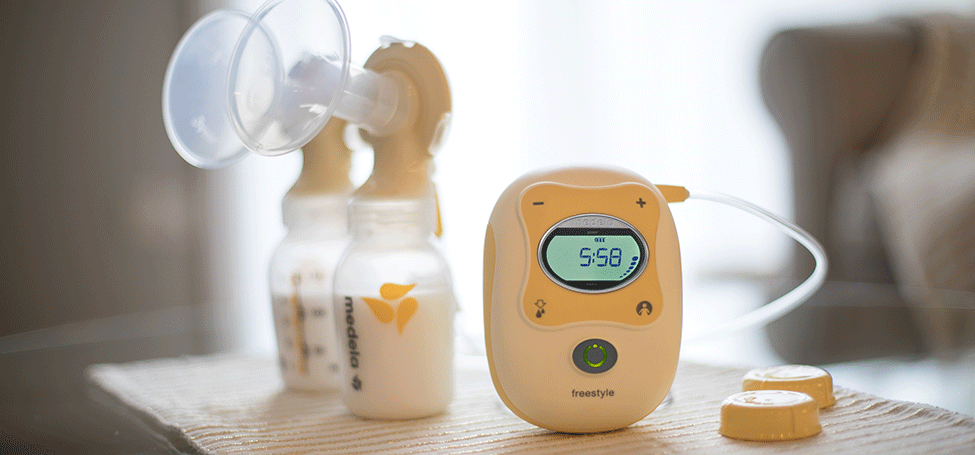

LCD Display, timer and two-level lighting function.Powered by an AC Adaptor or rechargeable internal battery (both included).All components that come in touch with milk are BPA-free.Pump is designed to be quiet while in use.Can be used as a single or double electric pump.Customizable pump settings to mom’s own response to follow her flow and find her best settings every time.2 Phase Cycling with Let-Down Button provides adjustable suction and cycling in let-down and expression mode.Backflow Protection technology protects breast milk and baby from bacteria, mold and viruses while pumping.

We hope this guide will help you and your bub stay healthy and enjoy a long and successful breastfeeding journey together. We recommend reading the manufacturer's instructions included in your breast pump. Not all breast pump parts are safe to sterilise in the microwave and some parts we recommend washing in warm soapy water only e.g. There are many different sterilisers on the market to assist you in the hygienic maintenance of your breast pump. Unimom Breast Pumps have a closed system which provides a barrier between the breastmilk and the air tube creating a hygienic environment within the breast pump itself. Simply allow the pump to run for a few minutes as the air flow will dry the tubing. However, if you get condensation in the tubing then mould or bacteria can thrive.
You don’t need to clean the tubing of an electric breast pump unless it comes into contact with breastmilk. Paper towel is prefferable to cloth towels as these can carry bacteria, however if you keep specific cloths for this purpose and disinfect them then this is sufficient. However if your baby is unwell, has thrush or you have thrush on your nipples then it is recommended that you sterilise your equipment after each use. This is a personal choice for a mother regarding the wellbeing of her baby. If you are expressing several times a day for a healthy baby, your expressing equipment should be rinsed well in cold water after each use to remove the milk. A mother's own expressing equipment does not need to be disinfected or sterilised for a healthy, term baby. The Australian Breastfeeding Association states: Reassemble your breast pump and store in a clean container in the fridge until your next use. Check and ensure that each part is completely dry.ġ0. Wash your hands again in soap and water.ĩ. Drain the attachments and bottles on a clean cloth and cover them while they air dry.Ĩ. Rinse all parts of the breast pump twice in hot water to remove any soapy residue.ħ. Ideally you will have a dishwashing or bottle brush specifically for this purpose.Ħ. Wash each part thoroughly in hot, soapy water and use a brush to access hard-to-reach places. Rinse each attachment in cold water to remove all traces of breastmilk.ĥ. On a clean bench or towel, disassemble all parts of your breast pump.Ĥ. Thoroughly wash your hands in soap and water and dry them on paper towel or a clean cloth.ģ. Use your breast pump and store the breast milk safely in the fridge or freezer.Ģ. This is our comprehensive guide to cleaning and maintaining your breast pump in pristine condition so that the protective benefits of your breastmilk are passed safely to your baby. It is even more important if your little one was born prematurely or had complications during birth. To further protect your baby from any airborne germs or viruses in the air, it is incredibly important to thoroughly wash, rinse, and dry your breast pump. Fortunately it isn’t the only option, and expressing and storing breastmilk is another way to ensure your little one is benefiting from your breastmilk, even when you’re away. Many mums want their babies to benefit from not only the nutritional aspects of breastmilk, but also the immunity boosting properties that to-date, have not been replicated by any commercial formulas. But for mothers who work or travel then breastfeeding is not always an option. In response specific antibodies to fight sickness will be produced by the mother’s body and passed through her breastmilk. However despite this inbuilt immunity and the availability of vaccinations, young babies still have an immature immune system that is not as strong as that of an adult or older child. 
Amazingly, new research indicates that babies ‘communicate’ to their mum through their saliva while breastfeeding. Newborn babies are born with a natural immunity that is passed on from their mothers through the placenta. This immunity is boosted and prolonged through breastfeeding, as a mother’s milk will provide antibodies to help combat illness or infection.







 0 kommentar(er)
0 kommentar(er)
